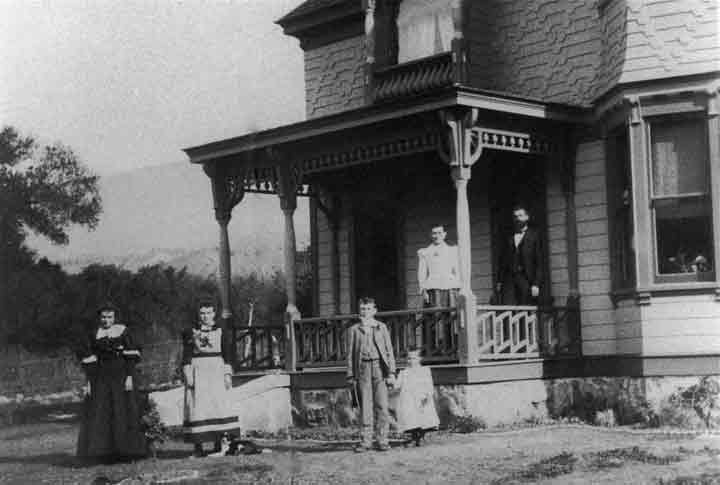
|
The home of one of Santa Paula’s first architects, Herman Anlauf, was built in 1893 at what is now 747 Ojai Road. The home is pictured here along with the Anlauf family on Christmas Day 1894. (Photo courtesy of Judy Triem) |
Stone’s ‘The Oaks of Santa Paula’ offers stories of time, place and character
August 17, 2011
By Peggy Kelly
Santa Paula News
Neighborhood: “A local community with characteristics that distinguish it from the areas around it.”
Actually, it’s also characters as well as those characteristics that make neighborhoods, and you have plenty of both in “The Oaks of Santa Paula” by area historian Mitch Stone. This new book from Fern Oaks Press offers a detailed look at the evolution of a distinctive part of Santa Paula, as set within the historical development of lower Santa Paula Canyon and the city as a whole.
And that, according to Stone, includes those pioneering settlements of the 1870s, and explores the key role the canyon played in the successful establishment of the town. It carries the story through to the transforming events of the 1920s, as the canyon began its conversion from an agricultural hinterland into the city’s prototypical suburb.
The book describes the area’s build-out in the postwar years to become the neighborhood known today as the Oaks. Also included in the book are sections on the artists and architects associated with the Oaks, and a description of many of the neighborhood’s most important homes and individuals. The book features nearly 100 illustrations, including maps and photographs, many from family collections and never previously published.
“I said I could do it from start to finish in 18 months... it took two years,” Stone said with a laugh during a recent presentation to the Santa Paula Rotary Club, of which he is a past president. “The Oaks of Santa Paula” retails for $31.95 and was published as a hand-numbered first edition hardcover book limited to only 600 copies.
Stone said he has been asked why “write a book about local history, why about such a small place as the Oaks? Well, it was an accident,” he joked, that resulted from the realization that he and companion Judy Triem “do research for a living” for their San Buenaventura Research Associates, but, “We knew little about our own house and neighborhood.”
How the Oaks fit into the bigger story of Santa Paula was just aspect of the story that Stone said continues: “I titled the book a history; not the history, but a history... when we write anything it starts a dialogue” that spawns more information as people talk about what they have read.
“There’s a dialogue that goes along with history,” and interconnections that encompass space and being; families that have circled out throughout generations, although some of the notable original homes have been lost. But not all, and that includes the residence of Harrison Crumrine, the second person to plant citrus in the area now known as the Citrus Capital of the World, whose home built more than 100 years ago remains the centerpiece of Cadway Street.
Stone said while writing the book he found he was constantly finding “a layer of history, one on top of another,” that would send him off in directions as different as the diverse Oaks neighborhood itself. Writing the book become one not only of journey into the past, but several surprises.
“The first was that the Oaks isn’t a place that can be as easily defined as we might assume,” but rather the majority stemmed from three residential tracts recorded in 1926-27: the Fern Oaks, Oakdale and Reddick subdivisions. And Stone also discovered numerous fascinating characters, including one of his now favorites, Wallace L. Hardison, whose business acumen had him firmly entrenched in both the fledging Union Oil (the now defunct Unocal) and Limoneira companies.
Another fascinating character was Louis Baumgartner, whose exploits include an early musical career, ownership of theaters and a baffling East Coast disappearance. When Baumgartner finally returned to Santa Paula he told a story of intrigue and loss. And almost exactly two years later Baumgartner called his mechanic to pick up his vehicle, sat in the car, and started it up in the enclosed garage, killing himself.
Most other Oaks residents had not only happier endings, but perhaps happier lives: Roy Wilson Sr. was the first licensed architect in Ventura County, while Douglas Shively was a successful banker and artist. In his later years Horace Bristol was a world acclaimed photographer.
Over the decades the Oaks has wrapped itself around many lives, been the scene of many stories, and remains a neighborhood of many friends. With chapters ranging from “Before the Oaks” and “A Thing of Beauty” to “Homes and People” and “The Oaks After the War,” the book is a fascinating read for those who are familiar to the area, as well as to those that never heard of the neighborhood.
This history of place and people is available at The Best of VC Marketplace, 108 N. 10th St., Santa Paula, and from Stone directly. Visit historicresources.com/oaks, or facebook.com/oaksofsantapaula. You can contact Stone at 805-525-2906 or email fernoakspress@gmail.com.



